

Netmeds First Membership
Quick Links
Introduction About IBGLOW ULTRA DEPIGMENTING CREAM
IBGLOW ULTRA DEPIGMENTING CREAM contains Hydroquinone which belongs to the group of medicines called Demelanizing agents. It is used to lighten the areas of darkened skin such as chloasma (brown patches appear on the face due to hormonal changes during pregnancy), melasma (skin problem caused by brown to gray-brown patches on the face due to sun exposure), freckles (small brown spots on skin often in areas that gets exposed to sun), age spots and acne scars.
Skin darkening is called as epidermal hyper-pigmentation and it is caused by deposit of too much melanin in the skin.
Before using IBGLOW ULTRA DEPIGMENTING CREAM, inform your doctor if you have any inflammatory skin conditions, skin cancer or taking any other medicines that cause sensitivity to light (Ex. chlorpromazine, doxycycline and amiodarone).
This medicine is not recommended for use if you are regularly exposed to sunlight for long hours. Your doctor may advise you to use sunscreen products in addition to IBGLOW ULTRA DEPIGMENTING CREAM to manage pigmentation on the skin.
IBGLOW ULTRA DEPIGMENTING CREAM is not recommended for use in pregnant and breastfeeding women. Also, it is not recommended for use in children (less than 12 years of age). The most common side effects of using IBGLOW ULTRA DEPIGMENTING CREAM are irritation, pain or swelling at the site of application, redness and skin dryness. Consult your doctor if any of the side effect gets worse or bothers you.
Uses Of IBGLOW ULTRA DEPIGMENTING CREAM
- Used to lighten the areas of darkened skin such as chloasma, melasma, freckles, age spots and acne scars
How IBGLOW ULTRA DEPIGMENTING CREAM Works
IBGLOW ULTRA DEPIGMENTING CREAM is used as a de-pigmentation agent on the skin to suppress the activity of cells called melanocytes. Melanocytes are responsible for producing melanin, which leads to the darkening of the skin. IBGLOW ULTRA DEPIGMENTING CREAM suppresses the overactivity of these cells by blocking the melanin production cycle, thus leads to fading of the brownish spots.
How to use IBGLOW ULTRA DEPIGMENTING CREAM
Apply IBGLOW ULTRA DEPIGMENTING CREAM as advised by your physician. It is for external use only. This medicine is applied using fingertips and rubbed evenly onto the affected area. Wash your hands immediately after applying IBGLOW ULTRA DEPIGMENTING CREAM. Avoid contact with eyes and avoid exposure to sun immediately after application of this medicine. Your doctor will decide the frequency of application and duration of IBGLOW ULTRA DEPIGMENTING CREAM for you depending upon your age and skin condition.
Side Effects Of IBGLOW ULTRA DEPIGMENTING CREAM
Common
- irritation, pain or swelling at the site of application
- red itchy rash on skin (allergic contact dermatitis)
- redness (erythema)
- skin dryness (xeroderma)
- burning and stinging sensation
Rare
- blue-black and/or grey-blue discoloration of the skin (which signifies some deposits in the deep layer of the skin (ochronosis))
Stop applying IBGLOW ULTRA DEPIGMENTING CREAM and consult your doctor immediately if you experience this side effect:
- signs of severe allergic reaction (such as hives, redness and extreme itching)
How To Manage Side Effects
Skin redness or itching:
Avoid hot showers because hot water can irritate your skin further. Do not scratch the affected area. Avoid sun exposure or UV rays as it may sensitize your skin. Use sunscreen and protective clothing when going outdoor. Regularly moisturize your skin after consulting the doctor. Consult your doctor if the symptom does not improve.
Skin dryness:
Drink lot of fluids. Apply moisturizer several times a day after consulting your doctor. Do not take bath for long time (not more than 5-10 minutes) and use warm water for bathing. Choose fabric clothes to wear. Consult your doctor if the symptom does not improve.
Warning & Precautions
Pregnancy
IBGLOW ULTRA DEPIGMENTING CREAM is not recommended for use in pregnant women due to lack of safety data. Consult your doctor before applying IBGLOW ULTRA DEPIGMENTING CREAM.
Breastfeeding
IBGLOW ULTRA DEPIGMENTING CREAM is not recommended for use in breastfeeding women due to lack of safety data. Consult your doctor before applying IBGLOW ULTRA DEPIGMENTING CREAM.
Allergy
Do not apply IBGLOW ULTRA DEPIGMENTING CREAM if you are allergic to hydroquinone or any other ingredients of this medicine.
Others
IBGLOW ULTRA DEPIGMENTING CREAM is not recommended for use if you:
- are regularly exposed to sunlight for long hours
Before applying IBGLOW ULTRA DEPIGMENTING CREAM inform your doctor if you:
- have any inflammatory skin condition or skin cancer
Use in Pediatrics:
IBGLOW ULTRA DEPIGMENTING CREAM is not recommended for use in children (less than 12 years of age) Consult your child’s doctor for advice.
Interactions
A. Drug-Drug Interactions:
Before applying IBGLOW ULTRA DEPIGMENTING CREAM, inform your doctor if you are taking any of the following medicines:
- chlorpromazine (used to manage symptoms of schizophrenia)
- doxycycline (used to manage bacterial infections)
- amiodarone (used to manage irregular heartbeat)
Overdosage:
It is unlikely to overdose with topical application of IBGLOW ULTRA DEPIGMENTING CREAM and in rare cases you may experience redness and burning sensation at the site of application. In case of accidental ingestion of IBGLOW ULTRA DEPIGMENTING CREAM, consult your doctor or visit the nearby hospital immediately, since IBGLOW ULTRA DEPIGMENTING CREAM is reported to be poisonous and may cause convulsions and haemolytic anaemia if ingested in large amount.
Synopsis
| Drug | : | Hydroquinone |
| Pharmacological Category | : | Bleaching agent |
| Therapeutic Indication | : | Chloasma, Melasma, Post-inflammatory Hyperpigmentation, Freckles |
| Dosage Forms | : | Cream, Lotion, Solution |
More Information
- Keep IBGLOW ULTRA DEPIGMENTING CREAM out of reach of children
- Store at room temperature
FAQs About IBGLOW ULTRA DEPIGMENTING CREAM
What is IBGLOW ULTRA DEPIGMENTING CREAM used for?
IBGLOW ULTRA DEPIGMENTING CREAM is used to lighten the areas of darkened skin such as chloasma (brown patches appear on the face due to hormonal changes during pregnancy), melasma (skin problem caused by brown to gray-brown patches on the face due to sun exposure), freckles (small brown spots on skin often in areas that gets exposed to sun), age spots and acne scars.
What are the common side effects of IBGLOW ULTRA DEPIGMENTING CREAM?
The most common side effects of using IBGLOW ULTRA DEPIGMENTING CREAM are irritation, pain or swelling at the site of application, redness (erythema), burning and stinging sensation, red itchy rash on skin (allergic contact dermatitis) and skin dryness. Consult your doctor if any of the side effect worsens.
Can IBGLOW ULTRA DEPIGMENTING CREAM be used in children?
No, IBGLOW ULTRA DEPIGMENTING CREAM is not recommended for use in children (less than 12 years of age). Consult child’s doctor for advice to select a suitable alternative therapy for your child to manage the specific condition.
Does IBGLOW ULTRA DEPIGMENTING CREAM cause skin redness or itching?
IBGLOW ULTRA DEPIGMENTING CREAM may cause skin redness or itching in some individuals. To manage this effect, avoid taking hot showers because hot water can irritate your skin further. Do not scratch the affected area. Avoid sun exposure or UV rays as it may sensitize your skin. Use sunscreen and protective clothing when going outdoor. Regularly moisturize your skin after consulting the doctor. Consult your doctor if the symptom does not improve.
How to apply IBGLOW ULTRA DEPIGMENTING CREAM?
Apply IBGLOW ULTRA DEPIGMENTING CREAM as advised by your physician. It is for external use only. This medicine is applied using fingertips and rubbed evenly onto the affected area. Wash your hands immediately after applying IBGLOW ULTRA DEPIGMENTING CREAM. Avoid contact with eyes and avoid exposure to sun immediately after application of this medicine. Your doctor may advise you to use sunscreen products in addition to IBGLOW ULTRA DEPIGMENTING CREAM to manage pigmentation on the skin.
References
1. KD. Tripathi. Drugs Acting on Skin and Mucous Membranes. Essentials of Pharmacology. Seventh 7th edition. 2013. Page – 886.
2. Xing, X., Chen, L., Xu, Z., Jin, S., Zhang, C. and Xiang, L., 2020. The efficacy and safety of topical tranexamic acid (liposomal or lotion with microneedling) versus conventional hydroquinone in the treatment of melasma. Journal of Cosmetic Dermatology [Revised in October 2020] [Accessed on 14th July 2022] https://onlinelibrary.wiley.com/doi/abs/10.1111/jocd.13810
3. Janney, M.S., Subramaniyan, R., Dabas, R., Lal, S., Das, N.M. and Godara, S.K., 2019. A randomized controlled study comparing the efficacy of topical 5% tranexamic acid solution versus 3% hydroquinone cream in melasma. NIH National Library of Medicine, National centre for biotechnology information. Pubmed.gov. [Revised in March 2019] [Accessed on 14th July 2022] https://www.ncbi.nlm.nih.gov/pmc/articles/PMC6484568/
4. Schwartz, C., Jan, A. and Zito, P.M. Hydroquinone. NIH National Library of Medicine, National centre for biotechnology information. Pubmed.gov. [Revised in May 2022] [Accessed on 14th July 2022] https://www.ncbi.nlm.nih.gov/books/NBK539693/
5. Omengue, A.M., Sobngwi, E., Dehayem, M., Balt, E.V., Boli, A.M., Choukem, S.P., Gautier, J.F. and Mbanya, J.C. Effect of Body Lotions on Capillary Blood Glucose Measurement–Interference of Hydroquinone-containing Body Lotion with Capillary Glucose Measurement. NIH National Library of Medicine, National centre for biotechnology information. Pubmed.gov. April 2018 [Accessed on 14th July 2022] https://www.ncbi.nlm.nih.gov/pmc/articles/PMC5954594/
6. Kauh, Y.C. and Zachian, T.F., Melasma. Rhemaderm. [Accessed on 14th July 2022] https://link.springer.com/chapter/10.1007/978-1-4615-4857-7_72
7. Sanchez, J.L. and Vazquez, M. A hydroquinone solution in the treatment of melasma. International Journal of Dermatology [Revised in January 1982] [Accessed on 14th July 2022] https://onlinelibrary.wiley.com/doi/abs/10.1111/j.1365-4362.1982.tb00496.x
8. New GPC, Inc. DailyMed. National Library of Medicine; National Institute of Health [Revised in October 2010] [Accessed on 14th July 2022] https://dailymed.nlm.nih.gov/dailymed/lookup.cfm?setid=2e53471e-ad03-4d6b-9384-4af374bb5f74
9. Axia Medical Solutions, LLC. Balancer-Hydroquinone cream. [Accessed on 14th July 2022] https://fda.report/DailyMed/7271877f-2ed5-4e58-84a1-dce3844a0bc5/#warnings









